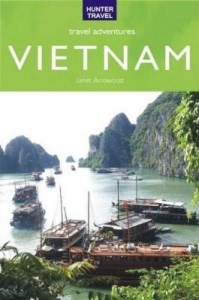Janet Arrowood is a long-time and frequent visitor to Southeast Asia. Huge lakes, tremendous waterfalls, elephant rides, jungles, wonderful people, fabulous food. The sense of the new and unknown will amaze you. Prices? Phenomenally low. And the scenery is spectacular. Canoe on Vietnam's historic lakes, kayak the South China Sea, see some of the largest waterfalls in the world, visit the islands, trek to hill-tribe areas, visit former royal palaces, wander through local markets. The imperial temples along the Perfume River are unforgettable. 'Travel Adventures' are about living more intensely, waking up to your surroundings and truly experiencing all that you encounter. Each book offers an ideal mix of practical travel info along with culturally enriching activities and physical adventures. And the fun is for everyone, no matter what his or her age or ability. Comprehensive background information - history, culture, geography and climate - gives you a solid knowledge of each destination and its people. Regional chapters take you on an introductory tour, with stops at museums, historic sites and local attractions. Places to stay and eat; transportation to, from and around your destination; practical concerns; tourism contacts - its all here! Detailed maps feature walking and driving tours. Then come the adventures - both cultural and physical - from canoeing and hiking to taking dance or cooking classes. This unique approach allows you to really immerse yourself in the local culture. This guide is based on our larger work, Vietnam, Laos & Cambodia, but it focuses primarily on Vietnam. A brief excerpt follows: Hanoi History - Hanoi is not all that old as international capitals go. It was first settled in the seventh century by Chinese invaders of the T'ang dynasty. They liked the climate, and growing conditions in the Red River Valley and Delta. Prior to this time there was just a small fort in the area. The Chinese held what they called Amman - the Pacified South - for about three centuries. For a century the site was abandoned, until King Le Thai To - the erstwhile founder of Hanoi - located his capital there. For most of the next 800 years (until the capital was moved to Hué) , Hanoi was the Imperial City. During this time the Chinese periodically invaded and retook the city, but their control never lasted very long. As a result, Hanoi saw a flowering of culture, with the founding of the country's first university - the outdoor Temple of Literature. From about the early 16th century, following the death of the last strong emperor, King Le Thanh Thong, the city underwent a gradual decline, and finally Emperor Gia Long moved his entire court to Hué in 1802. As a provincial backwater, the remnants of the former Imperial city were easy picking for the French invaders, and in 1882, they took over, named the area Tonkin, and made Hanoi the seat of government for the entire region in 1887. So it remained until the French were pushed out of the North in 1954. That's when the city once again became the capital of Vietnam. Arriving in Hanoi - If you come in by bus you are going to end up at one of the three long-distance bus centers, none of which are centrally located. Plan on taking a taxi to your hotel, at a cost of about $10. If you come in by mini-bus you may be able to negotiate a drop-off at the hotel of your choice for a small additional fee. The train station is only about a kilometer from the center, and a bit farther from the old French Quarter. A taxi should cost a few dollars to get to hotels in those areas. I recommend not taking a taxi alone - you may need a witness in case the driver decides to raise the agreed price and refuse to give you your luggage until you pay up. Two Westerners are usually enough to preclude this behavior. Rental cars are not usually a problem - the hotel or car service collects the money from you and handle
Vietnam Travel Adventures
Sobre
Talvez você seja redirecionado para outro site












